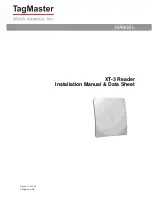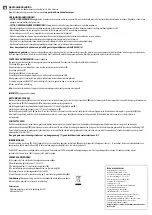
Section 8. Operation
2. Sets the excitation, and then settle, and then
measure
3. Reverse the excitation, and then settles, and then
measure
4. Reverse the excitation, reverse the input terminals, settle,
measure
5. Reverse the excitation, settle,
measure
There are four delays per
measure
. The CR1000 processes the four sub-
measurements into the reported measurement. In cases of excitation reversal,
excitation time for each polarity is exactly the same to ensure that ionic sensors do
not polarize with repetitive measurements.
Read More
A white paper entitled "The Benefits of Input Reversal and
Excitation Reversal for Voltage Measurements" is available at
www.campbellsci.com
.
Ground Reference Offset Voltage
When
MeasOff
is enabled (=
True
), the CR1000 measures the offset voltage of
the ground reference prior to each
VoltSe()
or
TCSe()
measurement. This offset
voltage is subtracted from the subsequent measurement.
From Background Calibration
If
RevDiff
,
RevEx
, or
MeasOff
is disabled (=
False
), offset voltage compensation
is continues to be automatically performed, albeit less effectively, by using
measurements from the automatic background calibration. Disabling
RevDiff
,
RevEx
, or
MeasOff
speeds up measurement time; however, the increase in speed
comes at the cost of accuracy because of the following:
1
RevDiff
,
RevEx
, and
MeasOff
are more effective.
2 Background calibrations are performed only periodically, so more time skew
occurs between the background calibration offsets and the measurements to
which they are applied.
Note
When measurement duration must be minimal to maximize measurement
frequency, consider disabling
RevDiff
,
RevEx,
and
MeasOff
when CR1000
module temperatures and return currents are slow to change.
Time Skew Between Measurements
Time skew between consecutive voltage measurements is a function of settling
and integration times, A-to-D conversion, and the number entered into the
Reps
parameter of the
VoltDiff()
or
VoltSE()
instruction. A close approximation is:
time skew = settling time + integration time + A-to-D conversion time
1
+
reps
2
1 A-to-D conversion time, which equals 15 µs.
2
If
Reps
>
1
(multiple measurements by a single instruction), no additional time
is required. If
Reps
=
1
in consecutive voltage instructions, add 15 µs per
instruction.
326
Summary of Contents for CR1000
Page 2: ......
Page 4: ......
Page 6: ......
Page 32: ......
Page 36: ......
Page 38: ......
Page 40: ......
Page 60: ...Section 4 System Quickstart Figure 16 PC200W View Line Graph 60 ...
Page 96: ......
Page 98: ...98 ...
Page 302: ......
Page 453: ...Section 8 Operation Figure 115 Using the Keyboard Display 453 ...
Page 456: ...Section 8 Operation Figure 118 Real Time Custom 456 ...
Page 457: ...Section 8 Operation 8 8 1 3 Final Memory Tables Figure 119 Final Memory Tables 457 ...
Page 458: ...Section 8 Operation 8 8 2 Run Stop Program Figure 120 Run Stop Program 458 ...
Page 460: ...Section 8 Operation Figure 122 File Edit 460 ...
Page 461: ...Section 8 Operation 8 8 4 PCCard Memory Card Display Figure 123 PCCard CF Card Display 461 ...
Page 478: ......
Page 506: ......
Page 536: ......
Page 636: ......
Page 642: ......
Page 644: ......
Page 676: ......
Page 677: ......
















































